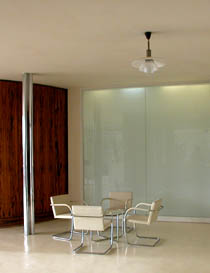
Delayed restoration of the Tugendhat villa will likely complicate the furnishing of the interior
 |
"In the project, we had a number of things pre-agreed, and many materials were pre-prepared," Tichý stated. This concerns atypical Makassar veneer, which is to cover the rounded wall in the dining room. The architects had it reserved in stock from a company that trades in exotic wood. However, the entrepreneur is unhappy that he still has to wait to sell the rare wood. There is a risk that he will sell the veneer to someone else, Tichý noted.
It would be difficult for the designers to source a new one. Veneers are typically made up to three meters wide, while the wall of the Tugendhat Villa needs a width of 3.2 meters. Moreover, the original veneer came from a very old tree from Ceylon, thus having a unique grain.
While there may be problems with some materials or equipment according to Tichý, others are currently stored somewhere and waiting for restoration. This applies to historical Strebel boilers, for example. One was discovered by architects in an apartment building that was to be reconstructed, and it was taken to a future restorer. The second one is in the basement of the castle in Lednice. Other materials are stored in the National Technical Museum in Prague.
A new static security project is currently being prepared for the monument restoration of the Tugendhat Villa. The originally proposed solution was rejected by conservationists as it interfered too much with the building's foundation. The construction is precisely what makes the Tugendhat Villa valuable. Thanks to it, architect Ludwig Mies van der Rohe (1886 to 1969) was able to clad the house with large glass panels, some of which could even be pushed into the ground. Mies, regarded as the father of modern architecture of the 20th century, thus realized his idea of a habitable continuous space; the surrounding environment literally entered the house through the glass walls.
The static solution is being developed by Jiří Starý, one of the experts who previously described the proposed solution as over-designed. The project should be completed by the end of February, and the design firm must then incorporate it into the budget. As soon as the solution is approved by the conservationists, according to Tichý, nothing will prevent the city council from announcing a tender for the construction company. "Work on the repairs could effectively begin in September," Tichý believes.
The Tugendhat Villa is the only Czech monument of modern art inscribed on the UNESCO World Heritage List. Its monument restoration was supposed to begin in 2002. However, disputes among the teams participating in the tender for the designer led to repeated delays in the start of the repairs. Later, further complications arose that delayed everything. Last year, the descendants of the original owners asked Brno for the return of the monument due to this. The councilors refused it.
The English translation is powered by AI tool. Switch to Czech to view the original text source.
0 comments
add comment











